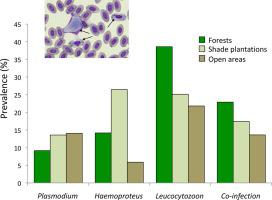International Journal for Parasitology ( IF 4 ) Pub Date : 2020-10-10 , DOI: 10.1016/j.ijpara.2020.08.005 S Reis 1 , M Melo 2 , R Covas 3 , C Doutrelant 4 , H Pereira 1 , R de Lima 5 , C Loiseau 6

|
Tropical forests are experiencing increasing impacts from a multitude of anthropogenic activities such as logging and conversion to agricultural use. These perturbations are expected to have strong impacts on ecological interactions and on the transmission dynamics of infectious diseases. To date, no clear picture of the effects of deforestation on vector-borne disease transmission has emerged. This is associated with the challenge of studying complex systems where many vertebrate hosts and vectors co-exist. To overcome this problem, we focused on an innately simplified system – a small oceanic island (São Tomé, Gulf of Guinea). We analyzed the impacts of human land-use on host-parasite interactions by sampling the bird community (1735 samples from 30 species) in natural and anthropogenic land use at different elevations, and screened individuals for haemosporidian parasites from three genera (Plasmodium, Haemoproteus, Leucocytozoon). Overall, Plasmodium had the highest richness but the lowest prevalence, while Leucocytozoon diversity was the lowest despite having the highest prevalence. Interestingly, co-infections (i.e. intra-host diversity) involved primarily Leucocytozoon lineages (95%). We also found marked differences between bird species and habitats. Some bird species showed low prevalence but harbored high diversity of parasites, while others showed high prevalence but were infected with fewer lineages. These infection dynamics are most likely driven by host specificity of parasites and intrinsic characteristics of hosts. In addition, Plasmodium was more abundant in disturbed habitats and at lower elevations, while Leucocytozoon was more prevalent in forest areas and at higher elevations. These results likely reflect the ecological requirements of their vectors: mosquitoes and black flies, respectively.
中文翻译:

土地利用和寄主物种对寄生虫丰富度、流行率和合并感染模式的影响
热带森林正受到多种人为活动的越来越大的影响,例如伐木和转为农业用途。预计这些扰动将对生态相互作用和传染病的传播动态产生重大影响。迄今为止,尚未出现森林砍伐对媒介传播疾病传播影响的清晰图景。这与研究许多脊椎动物宿主和载体共存的复杂系统的挑战有关。为了克服这个问题,我们专注于一个天生的简化系统——一个小的海洋岛屿(几内亚湾圣多美)。我们通过在不同海拔的自然和人为土地利用中对鸟类群落(来自 30 个物种的 1735 个样本)进行采样,分析了人类土地利用对宿主 - 寄生虫相互作用的影响,疟原虫、嗜血杆菌、白细胞动物)。总体而言,疟原虫的丰富度最高,但流行率最低,而白细胞动物的多样性最低,但流行率最高。有趣的是,共感染(即宿主内多样性)主要涉及白细胞动物谱系(95%)。我们还发现鸟类种类和栖息地之间存在显着差异。一些鸟类的流行率较低,但寄生虫的多样性很高,而另一些鸟类的流行率较高,但感染的谱系较少。这些感染动态很可能是由寄生虫的宿主特异性和宿主的内在特征驱动的。此外,疟原虫在受干扰的栖息地和低海拔地区更丰富,而白细胞动物在森林地区和高海拔地区更为普遍。这些结果可能反映了它们的载体的生态要求:分别是蚊子和黑蝇。



























 京公网安备 11010802027423号
京公网安备 11010802027423号